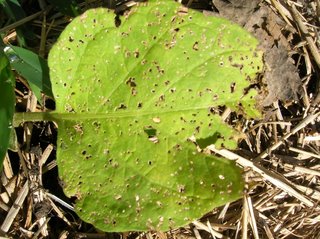Flea Beetle
Flea Beetles
The pic below shows a heavily damaged leaf of an eggplant seedling. The Flea Beetles seems to target the eggplant specifically, though they do damage to other plants as well. You can see that the leaf is yellowing as well. If you let a flea beetle infestation get out of control it can rapidly defoliate the plants.
 Here is a picture that gives you an idea of the size of these beetles. They are tiny, and they jump like flea when you disturb the leaves of the plant. But they are pretty easy to manually kill.
Here is a picture that gives you an idea of the size of these beetles. They are tiny, and they jump like flea when you disturb the leaves of the plant. But they are pretty easy to manually kill. Close up
Close up Control:
Control:The flea beetles overwinter in the adult form in debris in the garden. If you keep the area clear you reduce the amount you have to deal with next spring, but there are benefits to keeping the soil mulched through the winter.
One preferred organic method for flea beetle control is trap cropping. I have not tried it this year, but I am considering it for next year. ATTRA (National Sustainable Agriculture Information Service) research shows that giant mustard and radish crops can act as good traps. Other methods that are suggested are row covers and sticky traps. I don't really like to use sticky traps b/c I seems to catch too many pollinators and predator insects that I don't want to kill.
My most effective means of control is either Neem oil or Pyrethrin from chrysanthemum flowers. I apply it about every 3 weeks to the eggplant and it is extremely gratifying b/c the insects stop feeding almost immediately. You have to look for damage regularly b/c the beetles return quickly. Once the real hot weather hits the flea beetle seems to be less bothersome, so there is no need to spray in August.

0 Comments:
Post a Comment
<< Home